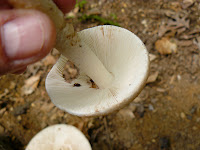 This morning I went on a foray organized by the Mycological Association of Washington at the Rock Creek Park in Washington, DC. The park is a great place for finding mushrooms and the foray was very agreeable. It rained a lot this last week and therefore there were many mushrooms growing, specially slime molds and polypores. Some of the specimens I remember were the long Xerula furfuracea, the buggy Megacollybia platyphylla, White Coral Slime (Ceratiomyxa fruticulosa), Stalked Scarlet Cup (Sarcoscypha occidentalis), Red Raspberry Slime (Tubifera ferruginosa), Turkey Tail (Trametes versicolor), Artist's Conk (Ganoderma applanatum), Coal Mushroom (Daldinia concentrica) and a nice cluster of three amanita mushrooms that we thought could be American Amidella (Amanita volvata) and which I decided to bring home to analyze more carefully (I brought home only one and I chose the intermediate sized one, which I used for the description below).
This morning I went on a foray organized by the Mycological Association of Washington at the Rock Creek Park in Washington, DC. The park is a great place for finding mushrooms and the foray was very agreeable. It rained a lot this last week and therefore there were many mushrooms growing, specially slime molds and polypores. Some of the specimens I remember were the long Xerula furfuracea, the buggy Megacollybia platyphylla, White Coral Slime (Ceratiomyxa fruticulosa), Stalked Scarlet Cup (Sarcoscypha occidentalis), Red Raspberry Slime (Tubifera ferruginosa), Turkey Tail (Trametes versicolor), Artist's Conk (Ganoderma applanatum), Coal Mushroom (Daldinia concentrica) and a nice cluster of three amanita mushrooms that we thought could be American Amidella (Amanita volvata) and which I decided to bring home to analyze more carefully (I brought home only one and I chose the intermediate sized one, which I used for the description below). As all Amanitas, this one had a volva (sac of tissue around the stem base), but contrary to most of them, this one did not have a ring around the stem. Mycologists use this information to help classify mushrooms, and since most amanitas are lethally toxic when eaten (with as small number of exceptions), one should pay a lot of attention to every detail when trying to identify amanitas, specially the presence or absence of rings and volvas. Other things that we noted immediately on these mushrooms was the large size (the biggest one had a cap that was probably 15 cm wide or wider) and the white color. On a more careful examination we observed that the mushroom bruised red/pink and that the gills under the cap were white. All these characteristics (and the ones described below) could suggest a member of the Amanita section Amidella.
After posting my photos and description at Mushroom Observer, Dr. Rodham Tuloss (an Amanita mycologist which has a very good website on Amanitas) sent me some comments and pointed out that "Amidellas are very hard to determine from a picture or even with one in your hand" and that ones has to rely on a microscope. Therefore for now I'll call this specimen just Amanita sp.
If this mushroom were indeed A. volvata, it would be a non-edible mushroom (as most Amanitas).
After posting my photos and description at Mushroom Observer, Dr. Rodham Tuloss (an Amanita mycologist which has a very good website on Amanitas) sent me some comments and pointed out that "Amidellas are very hard to determine from a picture or even with one in your hand" and that ones has to rely on a microscope. Therefore for now I'll call this specimen just Amanita sp.
If this mushroom were indeed A. volvata, it would be a non-edible mushroom (as most Amanitas).
Habitat
Growing on soil, near dead wood, gregarious, cluster of two specimens very close to each other and another approximately 50 cm away.
 Description
Description
Pileus – white, dull, dry, with remnants of the universal veil (appressed scales), bruises initially light red and then becomes brown very slowly, round, convex to flat, flesh is white, margin is striated.
Hymenium – gilled, gills are white, crowded, free, smooth, margin is entire, crenate.
Stipe – white, hollow with cottony cluster inside, cartilaginous, tapered toward apex, with white and elongated volva at the base, flocose near apex, inserted, smell is weak and non-distinctive.
Measurements
 Pileus height – 22 mm
Pileus height – 22 mm
Pileus diameter – 48-50 mm
Stipe diameter at apex – 8 mm
Stipe diameter at middle – 9.5 mm
Stipe diameter at base – 13 mm
Stipe length – 120 mm
Volva height – 4.5 cm
Growing on soil, near dead wood, gregarious, cluster of two specimens very close to each other and another approximately 50 cm away.
 Description
Description Pileus – white, dull, dry, with remnants of the universal veil (appressed scales), bruises initially light red and then becomes brown very slowly, round, convex to flat, flesh is white, margin is striated.
Hymenium – gilled, gills are white, crowded, free, smooth, margin is entire, crenate.
Stipe – white, hollow with cottony cluster inside, cartilaginous, tapered toward apex, with white and elongated volva at the base, flocose near apex, inserted, smell is weak and non-distinctive.
Measurements
 Pileus height – 22 mm
Pileus height – 22 mmPileus diameter – 48-50 mm
Stipe diameter at apex – 8 mm
Stipe diameter at middle – 9.5 mm
Stipe diameter at base – 13 mm
Stipe length – 120 mm
Volva height – 4.5 cm







No comments:
Post a Comment